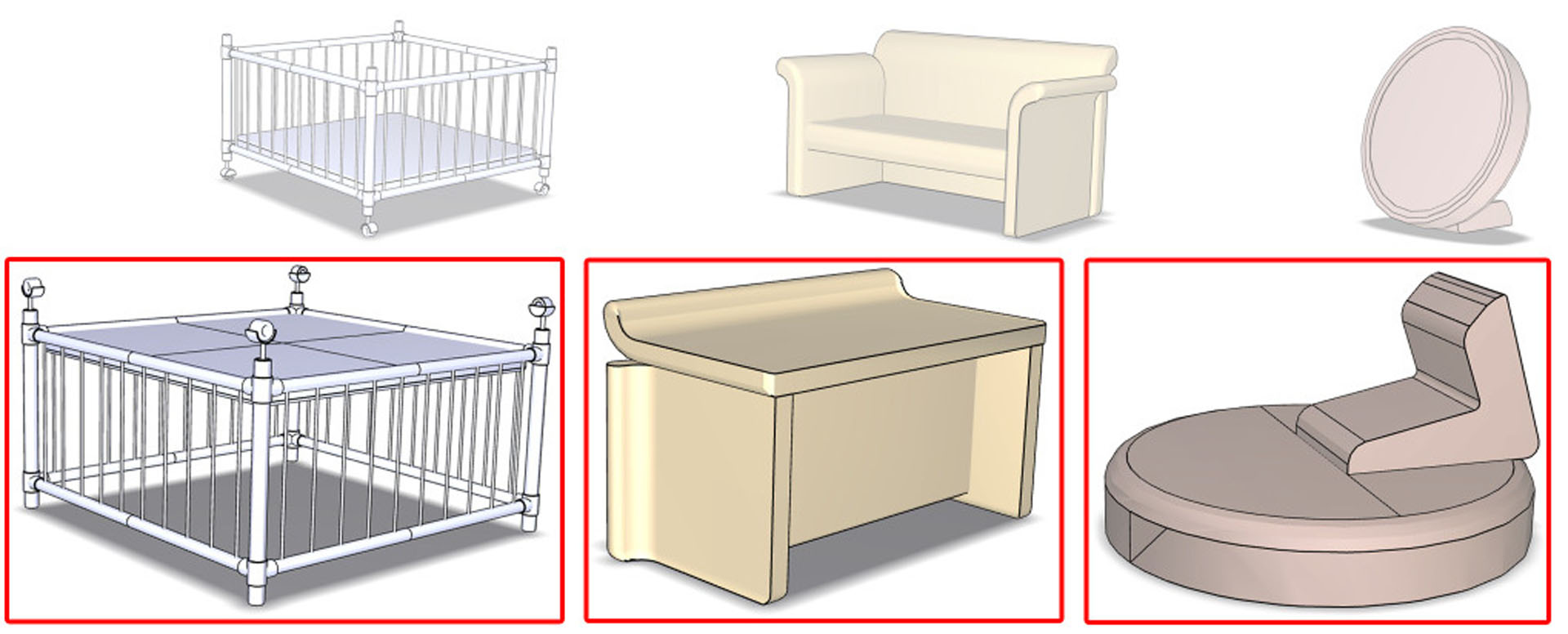“Upright orientation of man-made objects” by Fu, Cohen-Or, Dror and Sheffer
Conference:
Type:
Title:
- Upright orientation of man-made objects
Presenter(s)/Author(s):
Abstract:
Humans usually associate an upright orientation with objects, placing them in a way that they are most commonly seen in our surroundings. While it is an open challenge to recover the functionality of a shape from its geometry alone, this paper shows that it is often possible to infer its upright orientation by analyzing its geometry. Our key idea is to reduce the two-dimensional (spherical) orientation space to a small set of orientation candidates using functionality-related geometric properties of the object, and then determine the best orientation using an assessment function of several functional geometric attributes defined with respect to each candidate. Specifically we focus on obtaining the upright orientation for man-made objects that typically stand on some flat surface (ground, floor, table, etc.), which include the vast majority of objects in our everyday surroundings. For these types of models orientation candidates can be defined according to static equilibrium. For each candidate, we introduce a set of discriminative attributes linking shape to function. We learn an assessment function of these attributes from a training set using a combination of Random Forest classifier and Support Vector Machine classifier. Experiments demonstrate that our method generalizes well and achieves about 90% prediction accuracy for both a 10-fold cross-validation over the training set and a validation with an independent test set.
References:
1. Blanz, V., Tarr, M. J., and Bülthoff, H. H. 1999. What object attributes determine canonical views? Perception 28, 5, 575–599.Google ScholarCross Ref
2. Breiman, L. 2001. Random forests. Machine Learning 45, 1, 5–32. Google ScholarDigital Library
3. Cohen-Steiner, D., Alliez, P., and Desbrun, M. 2004. Variational shape approximation. ACM Trans. Graph. 23, 3, 905–914. Google ScholarDigital Library
4. Duda, R. O., Hart, P. E., and Stork, D. G. 2000. Pattern Classification, Second Edition. Wiley-Interscience, October. Google ScholarDigital Library
5. Fabri, A., Giezeman, G.-J., Kettner, L., Schirra, S., and Schönherr, S. 2000. On the design of CGAL, a computational geometry algorithms library. Softw. Pract. Exper. 30, 11, 1167–1202. Google ScholarDigital Library
6. Iyer, N., Jayanti, S., Lou, K., Kalyanaraman, Y., and Ramani, K. 2005. Three-dimensional shape searching: state-of-the-art review and future trends. Computer-Aided Design 37, 5, 509–530. Google ScholarDigital Library
7. Joachims, T. 1999. Making large-scale support vector machine learning practical. In Advances in Kernel Methods: Support Vector Machines. MIT Press. Google ScholarDigital Library
8. Kazhdan, M., Funkhouser, T., and Rusinkiewicz, S. 2003. Rotation invariant spherical harmonic representation of 3D shape descriptors. In SGP ’03, 156–164. Google ScholarDigital Library
9. Kriegman, D. J. 1997. Let them fall where they may: capture regions of curved objects and polyhedra. Int. J. Rob. Res. 16, 4, 448–472. Google ScholarDigital Library
10. Lee, C. H., Varshney, A., and Jacobs, D. W. 2005. Mesh saliency. ACM Trans. Graph. 24, 3, 659–666. Google ScholarDigital Library
11. Lumini, A., and Nanni, L. 2006. Detector of image orientation based on Borda Count. Pattern Recogn. Lett. 27, 3, 180–186. Google ScholarDigital Library
12. Luo, J., and Boutell, M. 2005. Automatic image orientation detection via confidence-based integration of low-level and semantic cues. IEEE Trans. Pattern Anal. Mach. Intell. 27, 5, 715–726. Google ScholarDigital Library
13. Mitra, N. J., Guibas, L. J., and Pauly, M. 2006. Partial and approximate symmetry detection for 3D geometry. ACM Trans. Graph. 25, 3, 560–568. Google ScholarDigital Library
14. Moll, M., and Erdmann, M. 2002. Manipulation of pose distributions. The International Journal of Robotics Research 21, 3, 277–292.Google ScholarCross Ref
15. Podolak, J., Shilane, P., Golovinskiy, A., Rusinkiewicz, S., and Funkhouser, T. 2006. A planar-reflective symmetry transform for 3D shapes. ACM Trans. Graph. 25, 3, 549–559. Google ScholarDigital Library
16. Saarinen, J., Levi, D. M., and Shen, B. 1997. Integration of local pattern elements into a global shape in human vision. Proc. Natl. Acad. Sci. USA 94, 8267–8271.Google ScholarCross Ref
17. Saleem, W., Wang, D., Belyaev, A., and Seidel, H.-P. 2007. Automatic 2D shape orientation by example. In SMI ’07, 221–225. Google ScholarDigital Library
18. Sheffer, A., and Hart, J. 2002. Seamster: inconspicuous low-distortion texture seam layout. In IEEE Visualization, 291–298. Google ScholarDigital Library
19. Shilane, P., and Funkhouser, T. 2007. Distinctive regions of 3D surfaces. ACM Transactions on Graphics 26, 2, 7. Google ScholarDigital Library
20. Shilane, P., Min, P., Kazhdan, M., and Funkhouser, T. 2004. The Princeton shape benchmark. In SMI ’04, 167–178. Google ScholarCross Ref
21. Simari, P., Kalogerakis, E., and Singh, K. 2006. Folding meshes: hierarchical mesh segmentation based on planar symmetry. In SGP ’06, 111–119. Google ScholarDigital Library
22. Snyder, J. M. 1995. An interactive tool for placing curved surfaces without interpenetration. In SIGGRAPH ’95, 209–218. Google ScholarDigital Library
23. Sullivan, L. H. 1896. The tall office building artistically considered. Lippincott’s Magazine.Google Scholar
24. Tangelder, J., and Veltkamp, R. 2004. A survey of content based 3D shape retrieval methods. In Shape Modeling Applications, 145–156. Google ScholarCross Ref
25. Vapnik, V. N. 1995. The Nature of Statistical Learning Theory. Springer-Verlag New York, Inc., New York, NY, USA. Google ScholarDigital Library
26. Vázquez, P.-P., Feixas, M., Sbert, M., and Heidrich, W. 2003. Automatic view selection using viewpoint entropy and its application to image-based modelling. Computer Graphics Forum 22, 4, 689–700.Google ScholarCross Ref
27. Wainwright, M. J., and Jordan, M. I. 2003. Graphical models, exponential families, and variational inference. Tech. Rep. TR 649, Department of Statistics, UC Berkeley.Google Scholar
28. Wang, Y. M., and Zhang, H. 2004. Detecting image orientation based on low-level visual content. Computer Vision and Image Understanding 93, 3, 328–346. Google ScholarDigital Library
29. Xu, K., Stewart, J., and Fiume, E. 2002. Constraint-based automatic placement for scene composition. In GI ’02.Google Scholar
30. Yamauchi, H., Saleem, W., Yoshizawa, S., Karni, Z., Belyaev, A., and Seidel, H.-P. 2006. Towards stable and salient multi-view representation of 3D shapes. In SMI ’06, 265–270. Google ScholarDigital Library




